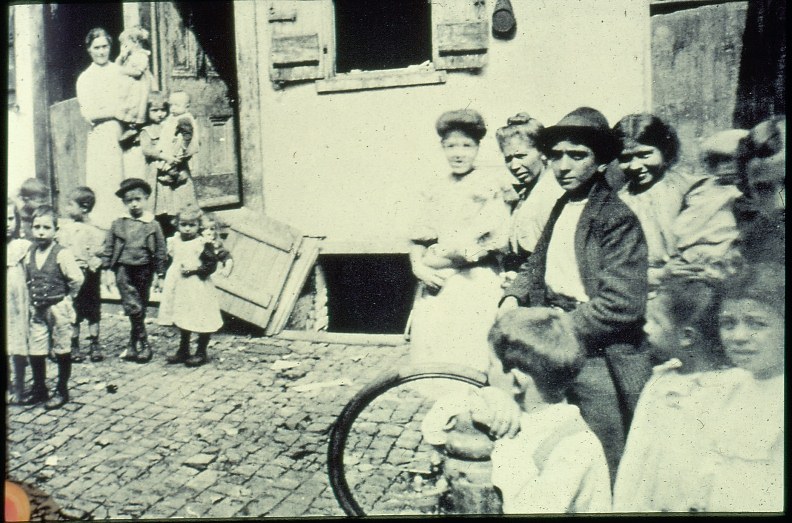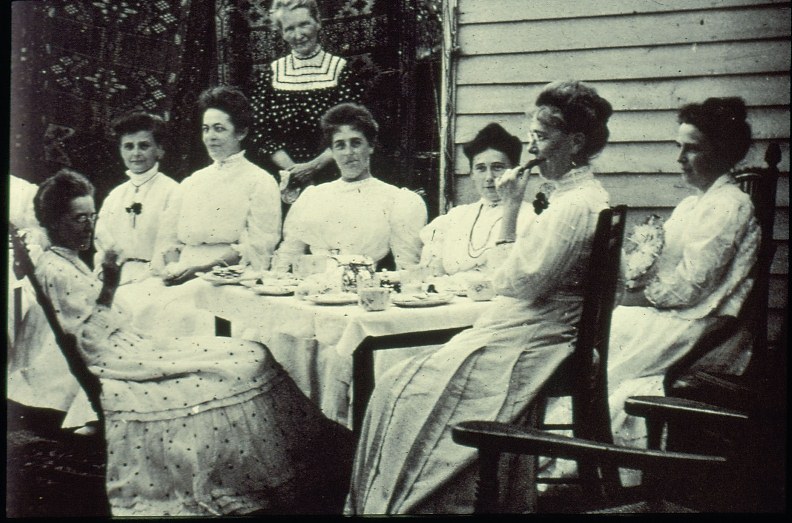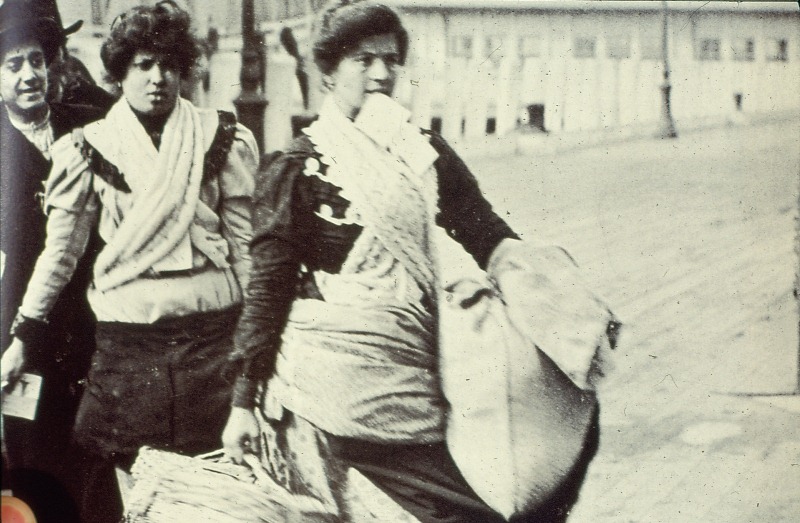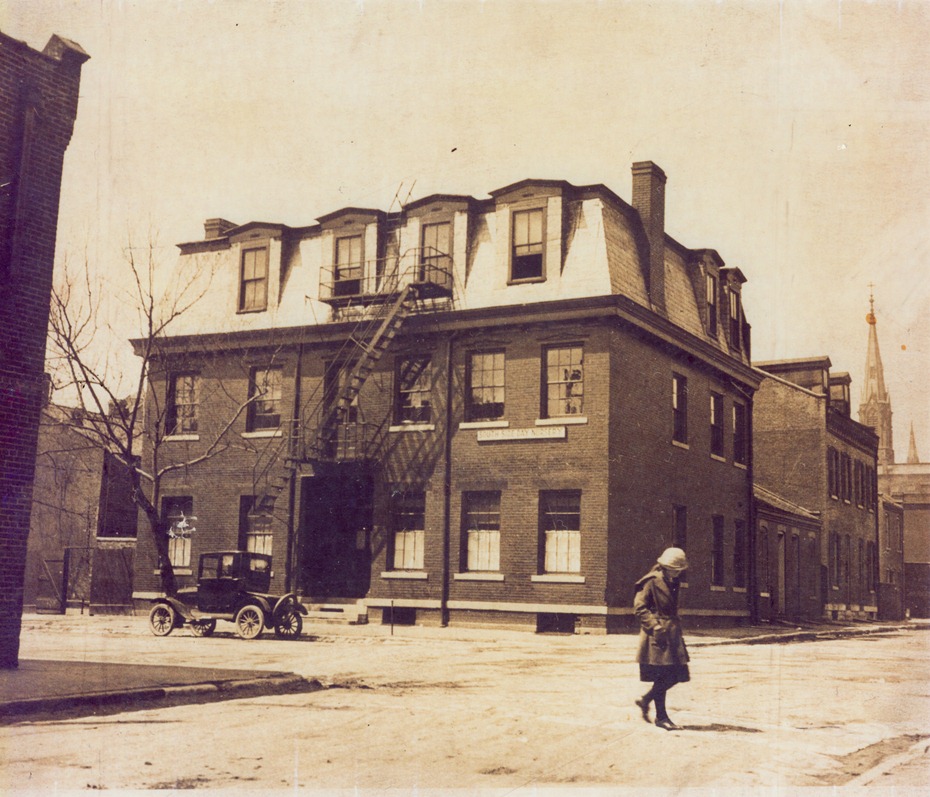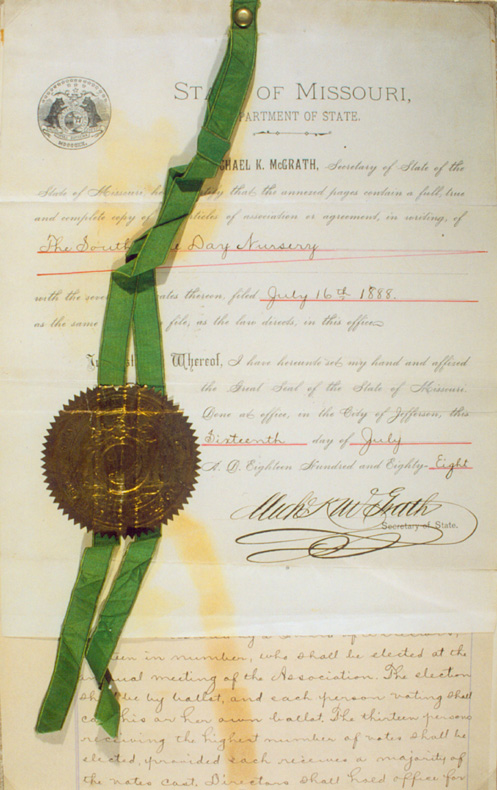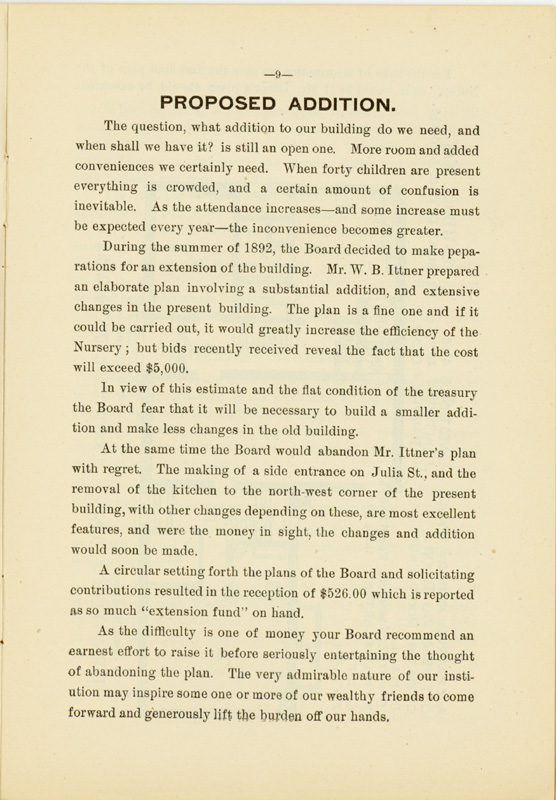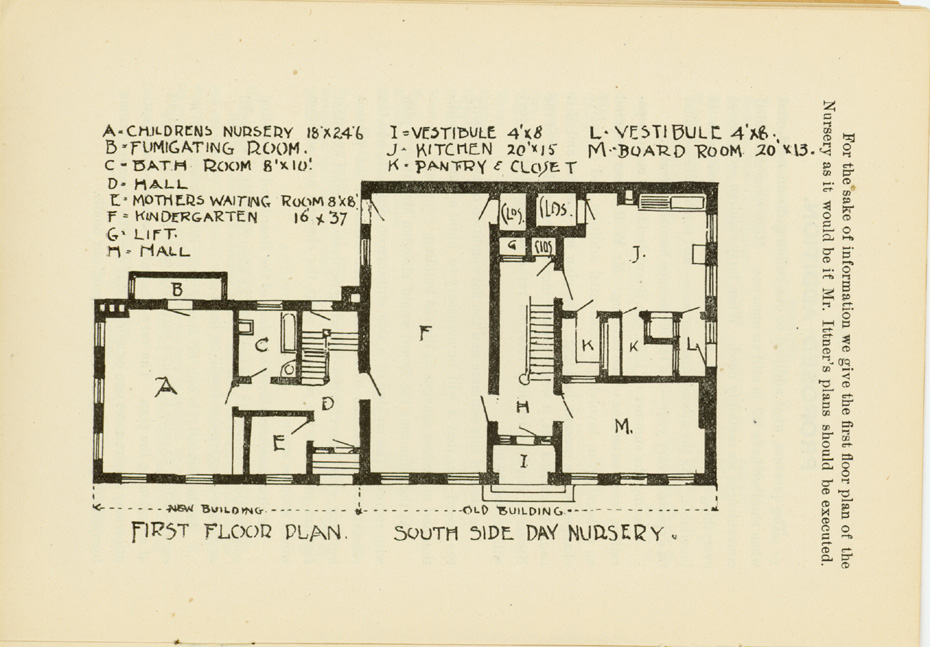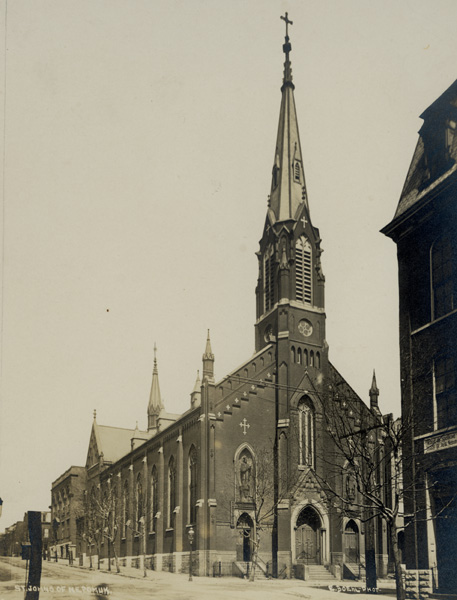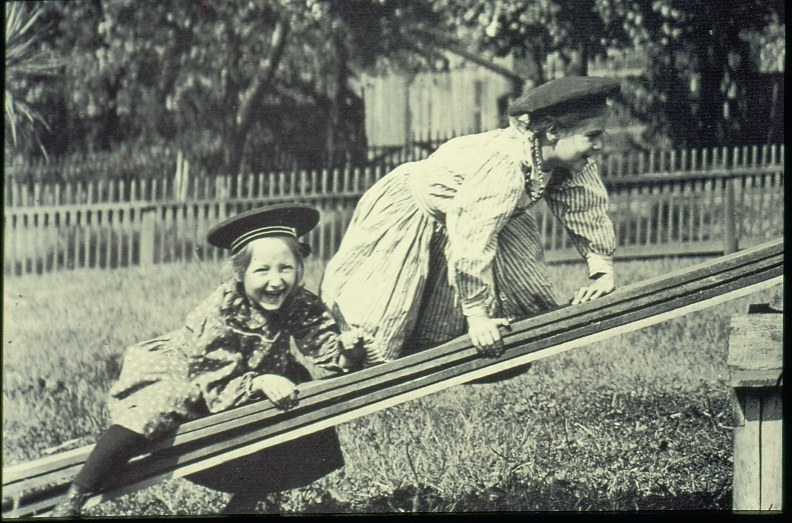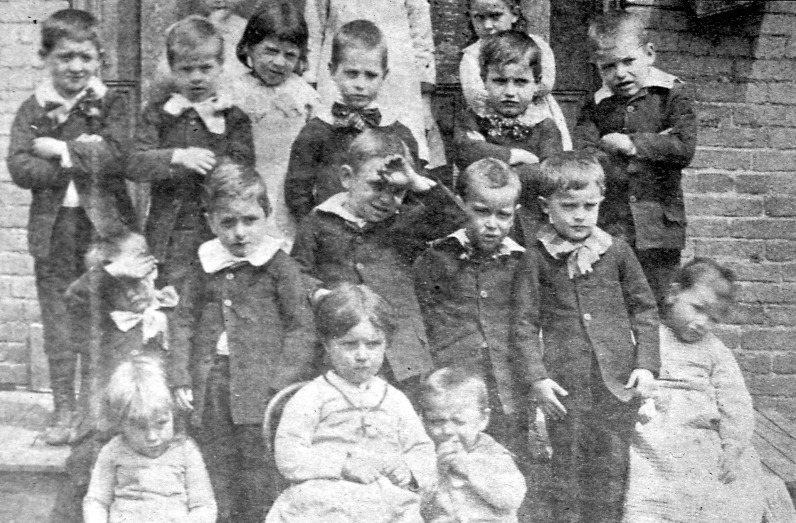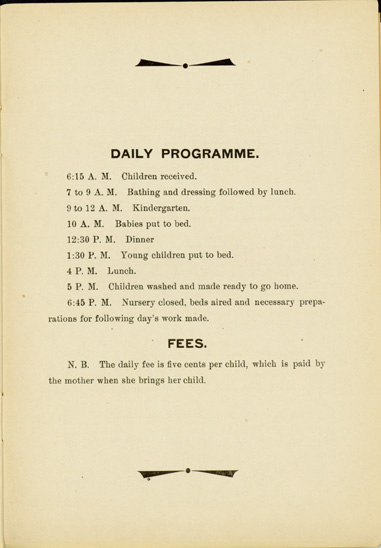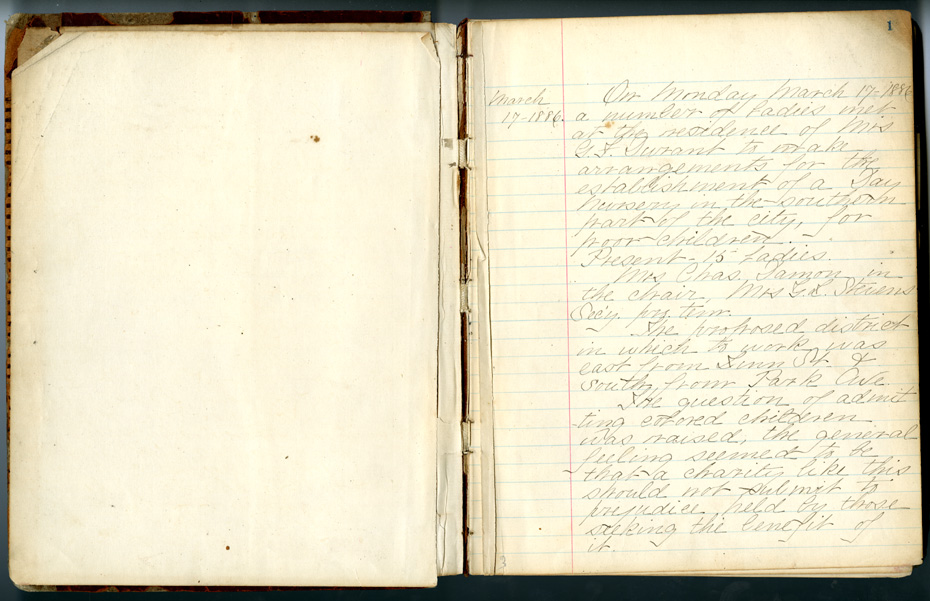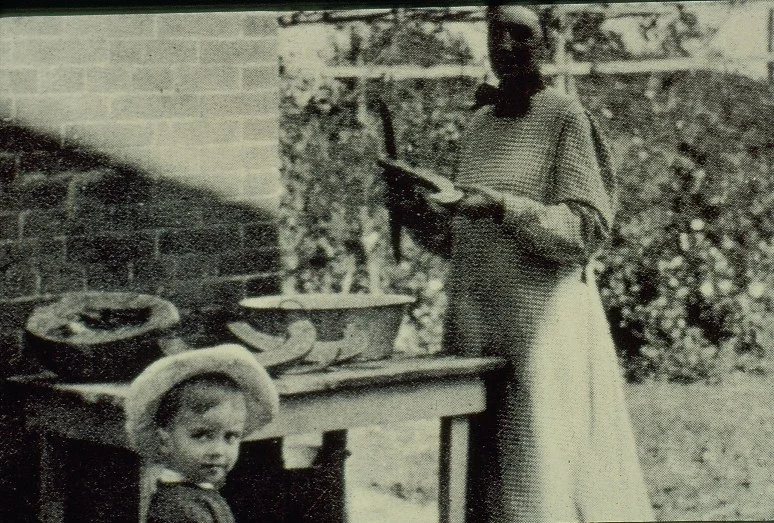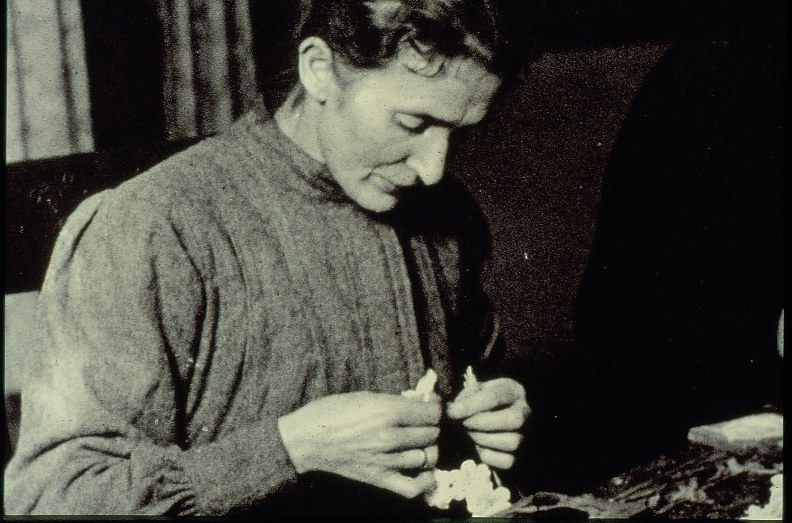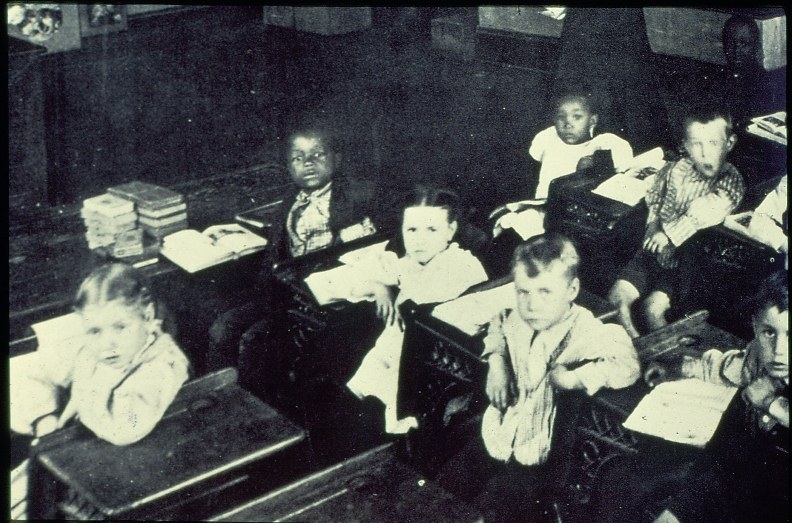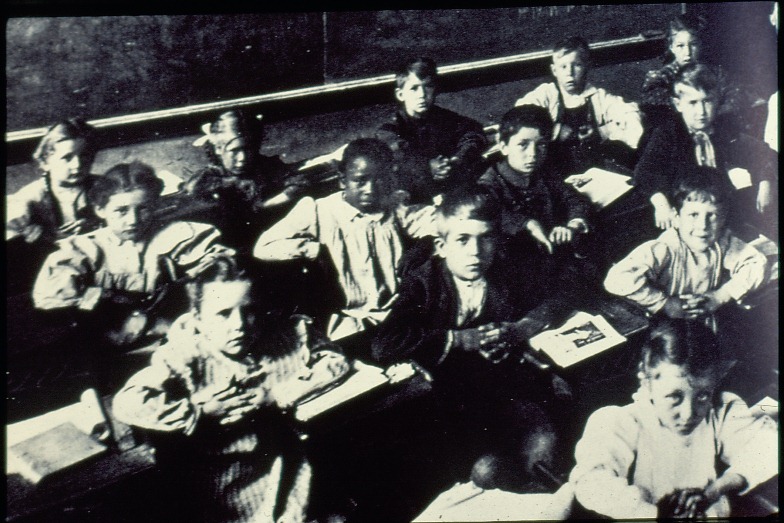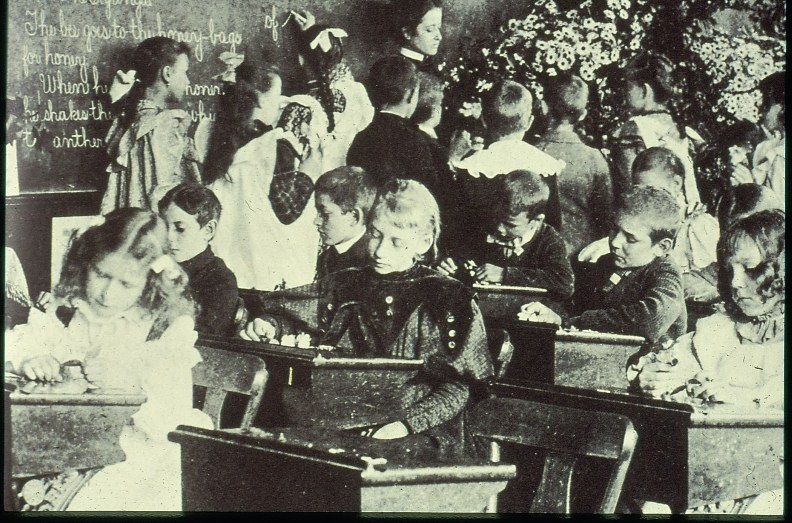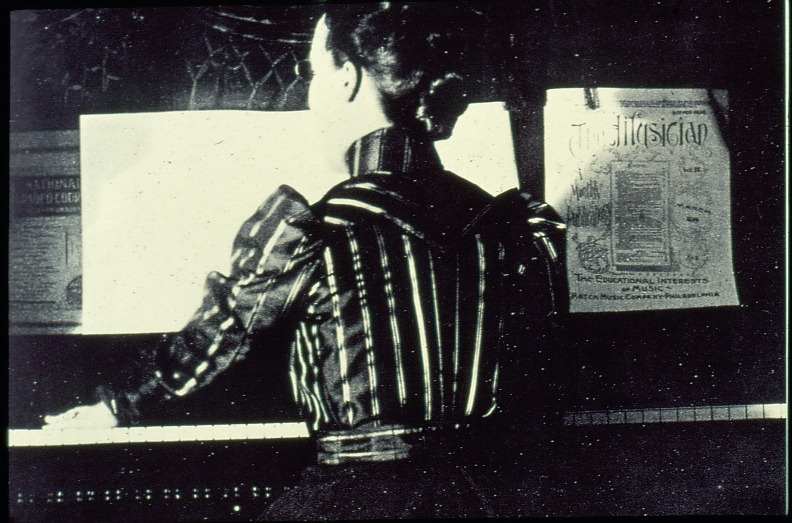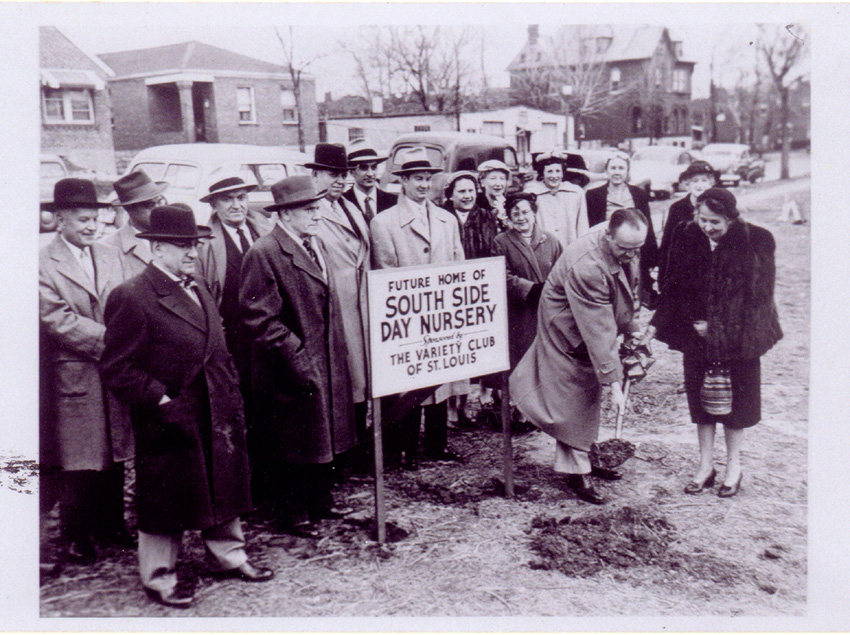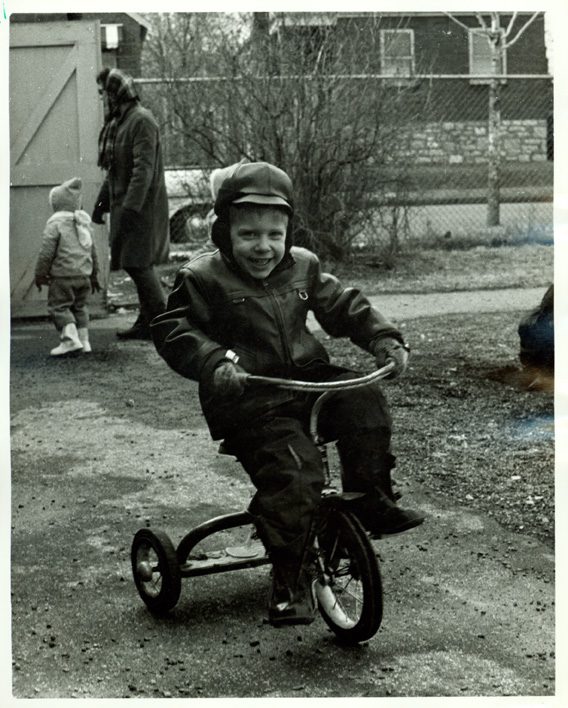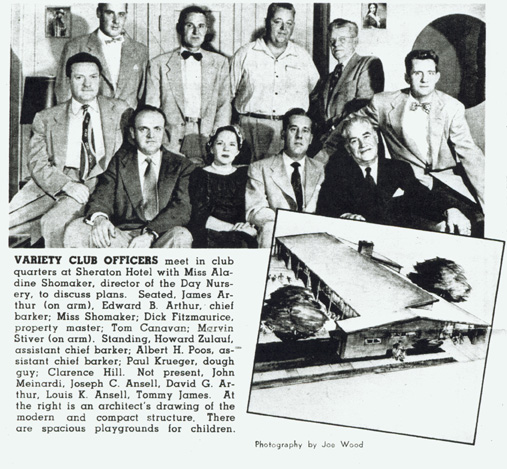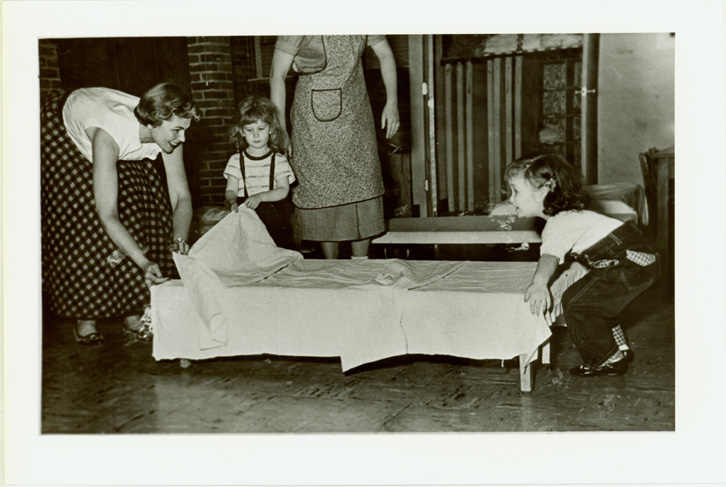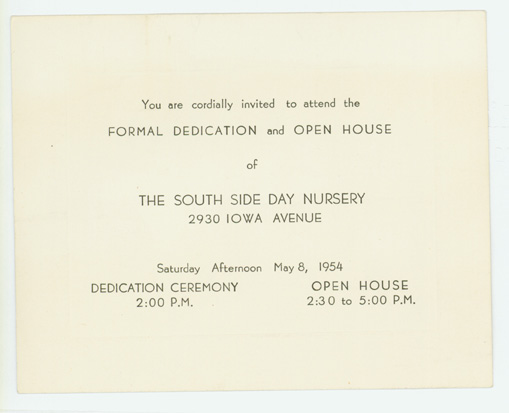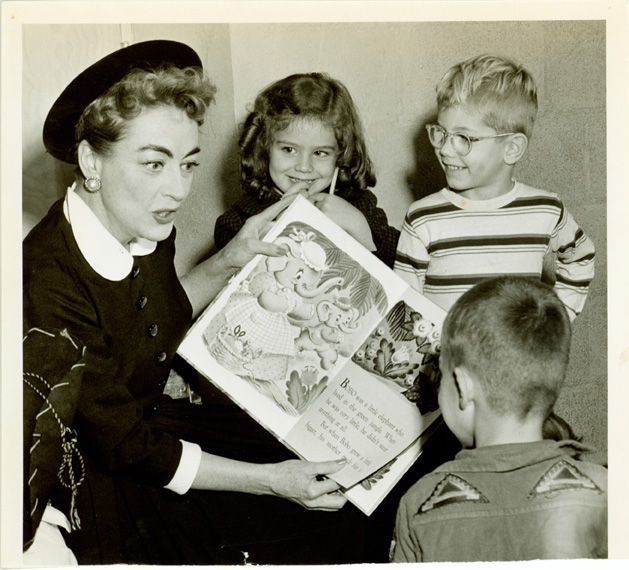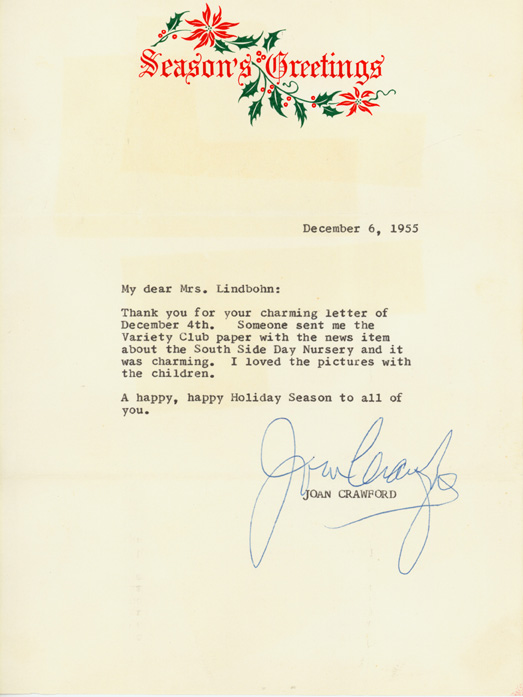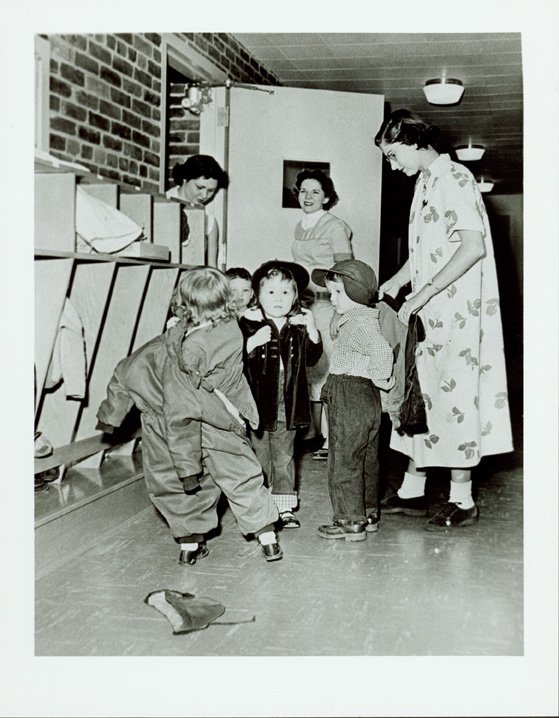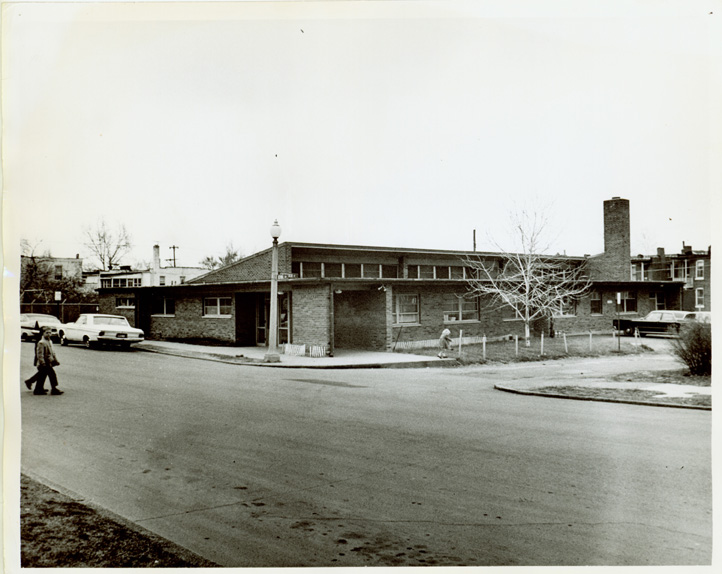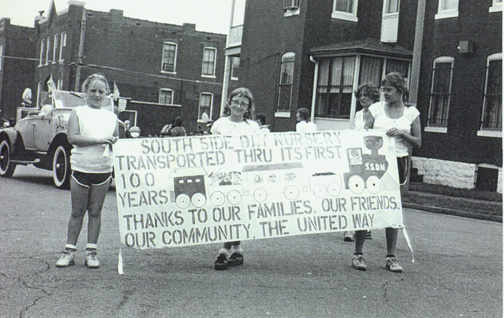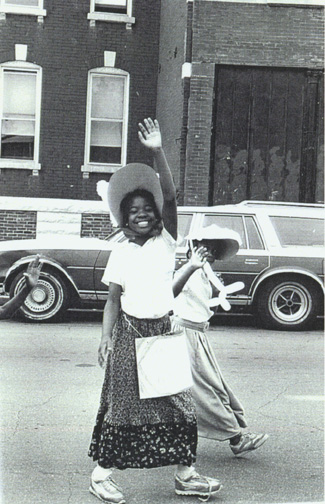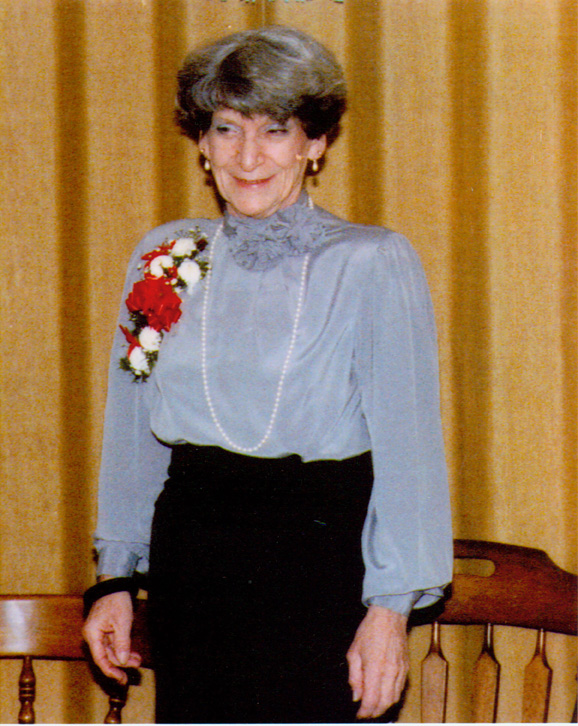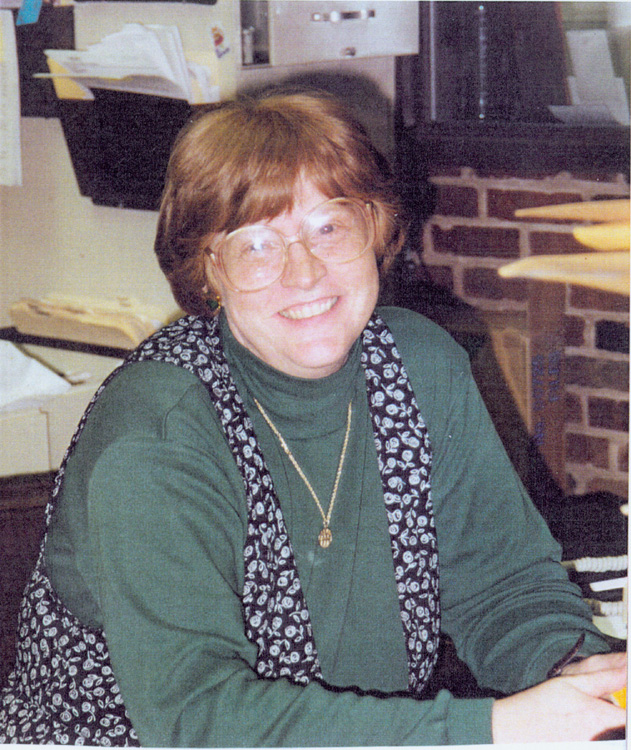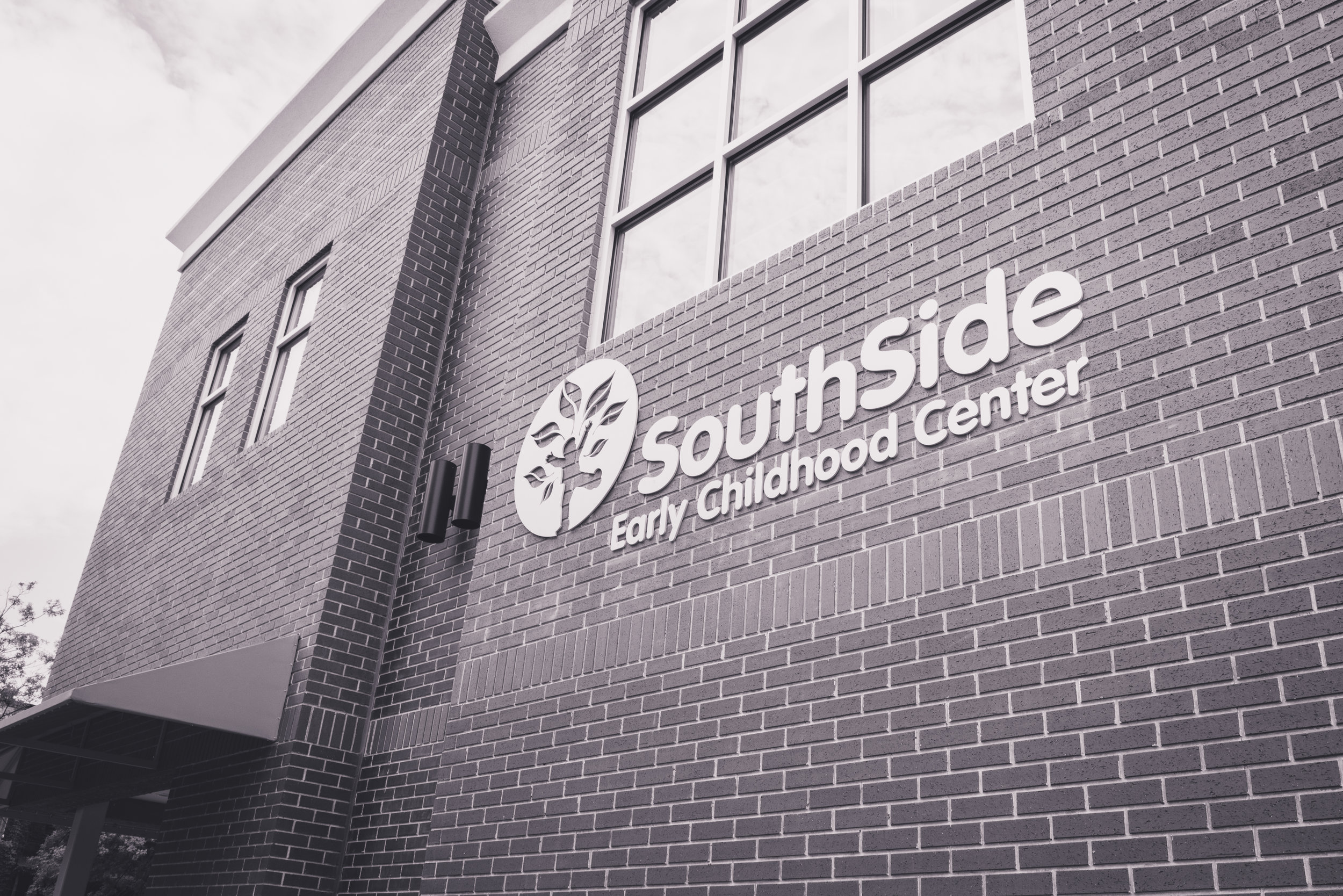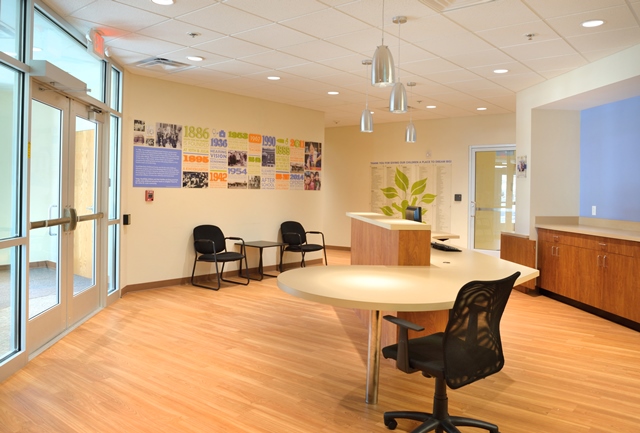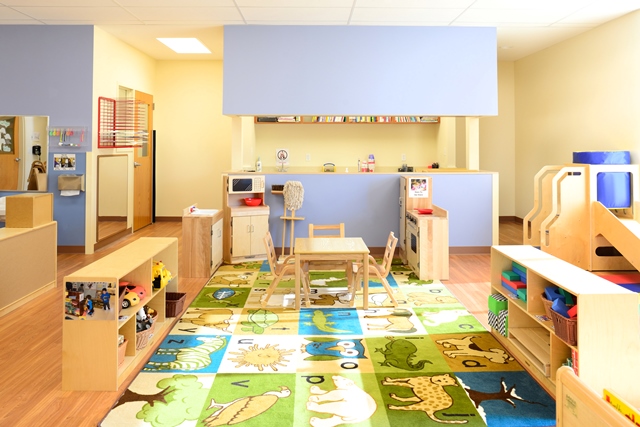
History
In 1886, a group of women created the first “day nursery,” or child care center, west of the Mississippi River. Today, that historic organization is called SouthSide Early Childhood Center. Explore this page to learn more about the challenges and successes that made SouthSide what it is today.
1880s
By 1880, industry was growing in St. Louis. Warehouses, factories, and small workshops filled the southern part the city. Of the women wage-earners in this area, some worked as hired domestic help for wealthier families. Others worked in factories. Working mothers had few choices for child care. Often a child would stay at home with an older sibling, or perhaps with a young girl the family could afford to pay.
RECOGNIZING A NEED
In 1886, the story of one seamstress sparked the idea for the South Side Day Nursery. The worker, who came from Milwaukee, told her employer that she had no safe place to leave her children during the day. Seeing a true need in the city, a group of women from a sewing group at St. Louis’s Church of the Unity decided to act.
THE FIRST MEETING
The first meeting took place on March 17, 1886. On that day, fifteen women met at the home of Mrs. G.F. Durant. In order to help the seamstress from Milwaukee and others like her, Mrs. Durant and her friends decided to create a ‘day nursery,’ or child care center, in the southern part of the city.
The women on the new Board quickly got to work. On May 3, the “South St. Louis Nursery” opened its doors. One child came that day. Since many people in the neighborhood spoke German or Bohemian, pamphlets were soon printed in those languages. By the end of its first year, South Side cared for as many as twenty-four children in a day.
LADIES OF THE BOARD
The Unitarian women who organized the South Side Day Nursery lived in a new middle-class neighborhood on St. Louis’s south side. Their long-term commitment allowed the South Side Day Nursery to have a stable organization for decades. Mrs. C. M. Woodward was president for twenty years, from 1887-1907. The next president, Mrs. Anthony Ittner, had the role for sixteen. Mrs. Stracke was a Board member for more than twenty-five years.
For many years, Mrs. Stracke worked on the Board’s Visiting Committee. In an effort to help families and the community as well as children, this committee regularly visited children’s homes and mothers’ workplaces. Members made 286 such visits in 1888 alone.
MISSION
“The object of the nursery shall be to prevent pauperism by assisting breadwinners with young children on their hands to earn an honest living.”
– Second Annual Report, 1888
SouthSide’s founders knew that providing childcare helped more than the child. They wanted to help solve the widespread problem of poverty in South St. Louis, and felt the best way to do this was helping families help themselves. Mothers paid five cents per day for a child to use the nursery. That same day, she could earn about one dollar at work. The early Board members proudly told supporters that the nursery helped these mothers earn a living without offering charity.
1621 S. TENTH STREET
Less than two weeks after the first meeting in March 1886, the new Board received some good news. Space in a two-story building at 1621 S. Tenth Street, formerly part of the Caroll School, was available. The layout, with two large rooms on either side of a hall, seemed suitable for a nursery. The property also had a yard that extended to the end of the block.
At first, the Caroll School let the new South Side Day Nursery use the rooms for free. After a few months, the Board had the option to rent the building. The founders worried that the rent of $35 per month was more than they could pay, but after some debate, they decided to stay. The brick building at the corner of 10th and Julia served as home to the South Side Day Nursery for 66 years—from 1886 until November 1951.
A PERMANENT HOMe
“For years then the nursery will be needed…the idea of purchasing some house suited to our purpose presents itself most strongly.”
—Second Annual Report, May 1, 1888
The women of South Side knew that working people would continue living in South St. Louis for many years. To help these future families, Board president Fanny Woodward urged the group to buy property. She strongly believed that the nursery should make a permanent home in the neighborhood.
In 1888 the South Side Day Nursery became incorporated, and so had the legal right to buy property. After spending more than a year fundraising, in May 1890 the nursery announced its success. For $5,000, South Side purchased its first home.
EXPANSION
As the South Side Day Nursery became more widely used, it needed more space. For years, the nursery once again raised money for its Building Fund. The most success came from a Doll Bazaar in 1895, at which crowds of people came to see or buy dolls from around the world.
In 1897, workers transformed the building at 1621 S. Tenth. New plumbing, new paint, a new hall, and an entire new third floor were added. The larger building meant that a greater number of children and families could be served.
THE NEIGHBORHOOD
From its first years, the South Side Day Nursery was truly a community organization. Most of the nursery’s first clients lived within two or three blocks of 10th and Julia. In 1890, it served nearly sixty families who lived within half a mile. Some working mothers moved to the area just to live near the nursery.
Most families in the neighborhood came from Germany or Bohemia. (Bohemia was part of what is now the Czech Republic.) An area called “Bohemian Hill” centered on St. John Nepomuk Church, just a few blocks from South Side. These German and Bohemian immigrants worked in nearby breweries, cotton factories, and foundries. By 1920, many families also came from Hungary, Sicily, Slovakia, Austria, and elsewhere. As the neighborhood changed, South Side continued to serve the community.
LIFE AT SOUTH SIDe
“The child is washed, fed three times daily, and made happy and comfortable for the day. A few years of such treatment has an influence for good on future lives which cannot be overestimated.”
—Fifth Annual Report, 1891
In the first years of the South Side Day Nursery, its main goals were to keep children safe, clean, and well fed. With many children and a range of ages to look after, little thought was given to educating the children. By the early 1890s the nursery served seventy-two families. On one day that year, the matron and two assistants looked after forty-four children. Nineteen were infants under one year old.
DAILY SCHEDULE
Nursery days were long, both for the children and the staff. Children began arriving before 7:00 each morning, and some stayed for ten or twelve hours. Upon arrival, the matron bathed each child and put him or her in clean clothes kept at the nursery. The day revolved around washing, meals, and naptimes. Infants were kept on the nursery’s second floor. Older children left to go to the Caroll School across the street for part of the day.
1890s
MORE THAN A NURSERY
“We have been fortunate in being able to supply the mothers with work, also to meet the demands made upon us for women to work.”
—Twenty-third Annual Report, 1909
The South Side Day Nursery acted as more than a child care center—it was also an informal employment agency. Mothers came to South Side looking for work, usually hoping to do a day’s worth of cleaning or laundry in someone’s home. The service worked the other way, too. In 1889, Board members visited seventy “lady employers” to inform them about South Side. As a result, households turned to the nursery for domestic help. In 1907 alone, the matron received 230 requests for women workers.
CHILDREN AND FAMILIES
“A charity like this should not submit to prejudice…”
–Board Minutes, March 17, 1886
From its beginning, the founders of South Side had to decide who they wanted to help. In the very first meeting, they decided to accept children of all races. Nevertheless, it took some time to overcome other common prejudices.
When the nursery first opened, only children of married or widowed working women were admitted. This meant that the Board rejected applications from unmarried mothers or working fathers. In September 1886, Nenny and Christian, the children of the local stone-cutter, were taken out of the nursery for this reason.
It took less than a year for this to change. In 1897, South Side accepted an application from Mrs. Hahn, an unmarried mother of twins. The Board decided from that point forward to look at each case one by one.
REMEMBERING MRS. PINCKERT
“She was a woman of great executive ability, kind to the children, tactful with the mothers, firm with her help, and very acceptable to the managers in every way.”
—23rd Annual Report, 1909
In the nursery’s second year, Emilie Pinckert was hired as matron, or head caretaker. Mrs. Pinckert became a fixture at South Side. For thirteen years, she cared for hundreds of children, managed staff and expenses, and found work for mothers. Mrs. Pinckert lived upstairs at 10th and Julia with her son, Waldemar. Her sister, Clara, also worked at the nursery. Like many people in the area, Emilie and Clara’s parents were German immigrants. When Mrs. Pinckert died in 1909, at age 48, the longtime matron left $100 to the nursery.
EXPANDING ROLES
“Yet we are doing much less than we ought…”
—Second Annual Report, 1888
From its earliest days, the people of South Side looked for ways to expand the nursery’s role in the community. In the early 1890s, the nursery started a kindergarten. This new part of South Side sparked an emphasis on education. Rather than worrying only about health and safety, the kindergarten focused on children’s learning and creativity. To help in this effort, the nursery joined with other groups in St. Louis and across the country. To serve a community need, South Side also began welcoming older children during lunch and after school hours.
1900s
A NEW KINDERGARTEN
“…the children have acquired freedom of expression and originality of thoughts. Through the music, drawing, and color work and contact with nature, they have manifested an innate love for the beautiful.”
—Fourteenth Annual Report, 1900
At first, children only attended the kindergarten on days when their mothers were at work. Over time, the teachers and Board realized that the children benefited more from a regular schedule. In 1899, it began accepting students for free on days when their mothers were not working. Five years later, when the nursery was in financial trouble, South Side’s lawyer recommended closing the kindergarten. Instead, members of the Board personally pledged to raise the needed money.
THE KINDERGARTEN MOVEMENT
Miss Emma Snyder is “an efficient kindergartner, and one who is truly filled with the spirit of Froebel.”
—Fourteenth Annual Report, 1900
In the kindergarten room at South Side sat a bust of Friedrick Froebel. Froebel, a German educator, started the kindergarten movement in the early 1800s. He taught that young children develop through structured crafts, music, and play. Like South Side, many early kindergartens also tried to help families in need. In 1873, Susan Blow started the first public-school kindergarten in the United States in St. Louis.
In this photograph, a woman at South Side plays a piano piece from a March 1899 issue of The Musician, part of “The Educational Interests of Music” monthly series.
A COMMUNITY EFFORT
“Resolved—that the South Side Day Nursery Association join the Missouri State Board of Women’s and Young Women’s Christian Associations, hoping to help and be helped in working for womankind”
—Monthly Board Minutes, January 1893
The South Side Day Nursery did not work alone in its mission. People and groups regularly donated time, money, and supplies. Board members often visited other charities, attended conferences, and read about the newest trends in child care. South Side joined the National Federation for Day Nurseries, the Provident Association, and more. In the years ahead, professional groups like these would play an even more important role in the history and development of the South Side Day Nursery.
1930s
GROWING and CHANGING
The 1930s and 1940s brought challenges both to the South Side Day Nursery and the country as a whole. In addition to the widespread problems of the Great Depression and World War II, in the early 1950s a new highway forced South Side to evacuate its longtime home.
Throughout these challenges, the South Side Day Nursery continued its mission to serve children, families, and the community.
As the Great Depression hit the country and St. Louis, South Side reached out to the neighborhood. In early 1931, the nursery set aside $100 for families in need. Board president Mrs. Meister wrote a letter to the National Employment Commission on behalf of working mothers. South Side distributed food baskets and welcomed local children for free lunches. On Thanksgiving, families received a turkey dinner at the nursery.
By the middle of the year, South Side was suffering. Staff salaries were cut, and then cut again. When the cook refused a $5 reduction in pay, Mrs. Meister fired her and asked local mothers to help in the kitchen instead. In the summer of 1933, the nursery closed its doors for the first time.
Despite the hardship, South Side was not defeated. The nursery reopened in September. That month, a mothers’ group also began at the nursery.
THE WAR YEARS
In St. Louis and across the country, World War II prompted women to enter the workforce. Of course, as South Side’s history shows, women worked outside the home long before the 1940s. Still, these new workers led to the Lanham Act, which devoted $6,000,000 to communities, including child care centers. Under the Works Progress Administration (WPA), two new teachers arrived at South Side.
Attendance increased through the war years, and South Side gave preference to defense workers. It stayed open six days every week instead of five. Despite help from the WPA, staffing was a problem. Girls hired to work at the nursery all quickly left for jobs in industry. Even the doctors who checked the children could be called into service at any time.
1940s
—United Charities’ 1942 report (click to zoom in)
ELIZABETH CLARK AND THE UNITED CHARITIES
In the uncertainty of the early war years, South Side applied to be part of the United Charities (now the United Way). At this time, the United Charities ran a new organization called the Metropolitan Bureau for War-Time Child Care. Elizabeth Clark, a consultant from this agency, visited South Side in March of 1943.
Clark represented a new way of doing child care. She had recommendations about everything from the color of the walls to the salary and education of the staff. Eager to modernize, South Side quickly evolved to meet the United Charities’ standards. In addition to funding, one major plus of joining the group was a new part-time social worker.
In 1942, the South Side Day Nursery applied to become a member of the United Charities.
CHANGES
By the 1940s, much more was known about how children learn and develop than in earlier decades. As a result, major changes happened at South Side. Teachers began splitting children up into different age groups. They also paid more attention to a child’s life at home. Records were now kept about each child’s physical, emotional, and intellectual progress. Social work became a regular service at South Side.
This new level of attention helped one boy in October 1947. This child’s father suffered from “a nervous condition believed due to the war.” South Side staff helped the father get treatment at the Barnes Clinic. Teachers noted how much happier the boy became once his family life felt more secure.
—News clippings about highway expansion (click to zoom in)
A HIGHWAY THREATENS
Even more drastic changes were in store for South Side. The City of St. Louis had plans for a new stretch of highway linking Gravois Road to Third Street and Clark Avenues. Building the highway meant destroying about 300 buildings, including the South Side Day Nursery.
For years, Senator Anthony Webbe worked to delay or stop the project. Webbe argued that low-income families in the area had nowhere else to go. Highway supporters believed delaying the project would mean losing federal funds. In the end, South Side and its neighbors were forced to leave. On November 1, 1951, the South Side Day Nursery closed.
1950s
—Seeking a new home (click to zoom in)
LOOKING FORWARD
While preparing to leave Tenth and Julia, Board members worked to find a new home for South Side. With the support of the Social Planning Council, in 1951 they bought a piece of land at the corner of Iowa Avenue and Crittendon Street.
The Board hired an architect, Art E. Koelle, to make plans. Before getting to work, Koelle inspected the new and old locations. He also talked to the director, Mrs. Russell, about what type of building was needed. Unlike the building at 10th and Julia, the South Side Day Nursery’s new building would be made with child care in mind.
—Fundraising brochure (click to zoom in)
FUNDRAISING
In order to build a new home, South Side needed $50,000. This was in addition to the money earned from selling the old building to the city. Many people and businesses contributed, including a woman named Mrs. Feuser. Years before, Mrs. Feuser had left her 7-month-old daughter Freida at South Side. Freida attended the nursery for 3 years. In thanks, Mrs. Feuser gave $500 to the building fund. When Mrs. Feuser died the next year, the grown Freida donated an additional $500.
Despite acts of generosity such as these, South Side struggled to raise enough money. The land at Iowa and Crittendon had been filled in over an old quarry, making building expensive. More than a year after leaving the old location, the Board still could not begin building.
—Variety Club's Harvest Moon Festival (click to zoom in)
THE VARIETY CLUB STEPS IN
In early 1953, the South Side Day Nursery received some very welcome news. The St. Louis chapter of the Variety Club had taken on child care as its charity cause. For its first major project, the Variety Club agreed to raise $40,000 for South Side’s new building. In support of the Building Fund, the Variety Club hosted a Harvest Moon Festival that November.
With plans moving forward, the Board hired Miss Aladine Shoemaker to be the first new director. The young Miss Shoemaker was finishing school in New York at the time, but soon she would be responsible for beginning the next phase of South Side’s history. Thanks to the Variety Club, groundbreaking for the new South Side Day Nursery took place on March 25, 1953.
The Variety Club’s Harvest Moon Festival raised money for South Side’s new building.
2930 IOWA AVE
“The new building, designed specifically for day care purposes, with its light modern airy playrooms fitted with built-to-scale furnishings and its large outdoor play space, is a just reward for the faith, hope and hard work of those who have carried the responsibility of its mission.”
—Annual Report for 1953
Though the building was not quite finished, Miss Shoemaker received the keys to the new South Side Day Nursery on December 12th, 1953. Quickly, the child care center was up and running. The first year in the new building, enrollment grew from nine to forty-one children. A part-time case worker set fees on a sliding scale, and South Side began a parents’ club.
The Variety Club continued showing support. In November 1955, it even arranged for famous movie star Joan Crawford to visit.
In 1953, Ula Neuoff brought bricks from 10th and Julia and had them placed at the front entrance of the new building on Iowa Ave. The year of South Side’s 75th anniversary, she became Board president. Ula claimed her best contribution to South Side over 40 years of service was hiring Barbara Torrence as Director in 1962.
1960s
“WHOM DO WE SERVE?”
At its new location, the South Side Day Nursery continued to evolve to meet the needs of families and the community. The 1960 Annual Report asked, “Whom do we serve?” The answers were many. For one, the report noted that mothers work for many reasons, including personal fulfillment and ambition. No matter what the reason for childcare, South Side promised to “strengthen family relationships and enrich the basic learning the child receives at home.”
“The responsibility of caring for 50 youngsters between the ages of 3 and 5 for most of their waking hours is a tremendous one, and over the years we have come to realize that while kind and loving care is essential, it is not enough! … Day care costs seem high because this is an all-encompassing job rather than a specialized one. It is not just education, or a good health program, or a family counseling service – it combines all three for 10.5 hours a day, 12 months a year.”
—1962 Annual Report
REACHING WIDE
In the following decades, SouthSide kept changing and growing to meet community needs. From participating in the government’s Head Start program, to building satellite centers for infant care, to helping local businesses develop and thrive, the organization that began in 1886 continues to serve children, families, and the community. Today, SouthSide Early Childhood Center’s mission is to nurture, educate and inspire children and families with limited resources, fostering healthy development and a strong foundation for success.
1980s
“The goals of the Nursery have changed little over the years, but the methods of attaining these goals have kept up with the changing needs of clients. South Side’s goal has always been to provide a quality day care program that helps each child realize his personal worth and importance and to foster his progress toward becoming a caring, sensitive person…It’s very heartening to realize that legions of people before us had a strong social conscience, faced dilemmas, worked out solutions, and kept the agency going through an entire century! We have a wonderful heritage.”
—Barbara Torrence, Executive Director, 1985
In 1986, Barbara Torrence retired as Executive Director after more than 20 years. Her successor, Marlene Levine, also stayed at South Side for more than 20 years. Both directors greatly expanded the services provided at the South Side Day Nursery.
2010s
A Bold Endeavor
In 2014, SouthSide Early Childhood Center launched a 4 million dollar capital campaign to build a new state-of-the-art school in South City. Building this facility had a deep impact on the children and families Southside serves, as well as the community at large. The construction of SouthSide spurred local economic development through job creation and contributed greatly to city beautification, while also creating a meaningful space to ‘level the playing field’ for our children.
“We are undertaking the bold endeavor to build—for the children and their families—a beautiful new school, creating an environment that will raise their hopes and expectations for the future.”
—Anne Lowell, SouthSide Executive Director, 2008–2015
Towards an Unstoppable Future
After realizing the vision of building a stronger, more beautiful SouthSide, Anne Lowell passed leadership to Dr. Katie Rahn, SouthSide’s current executive director. To read about the latest work being done by the SouthSide team, please visit our Media Center.
“Rather than drive our organization as a reaction to what is wrong or unfair, we are driven by the real and incredible opportunity to have a hand in reshaping the future. To provide opportunity so that every child can discover the magnitude of his or her potential. To position a child that might otherwise be left behind as a pioneer to lead the way.”
—Dr. Katie Rahn, Executive Director, 2016-current
2020s
The First Step To Equity
In 2018, SouthSide collaborated with IFF—with the support of the Missouri Foundation for Health, the St. Louis Community Foundation, the PNC Foundation, the William T. Kemper Foundation, and the Goldstein Family Foundation—to conduct a needs assessment around early childhood education in the St. Louis region (read the assessment here). A significant needs gap was identified: only 50% of children between the ages of 0 to 5 in the City of St. Louis and St. Louis County have access to high-quality early childhood education. In 2019, the completed study resulted in a comprehensive report that sought to better understand and answer why our early childhood education system is so inequitable in St. Louis, as well as identify systemic issues causing the service gap. Five areas were identified to create a stronger ECE system in St. Louis: (1) strengthen the ECE workforce, (2) increase access to subsidized care, (3) make quality a priority, (4) coordinate across the board, and (5) set equity as the goal.
SouthSide put the results and recommendations of the First Step to Equity report into action in myriad ways. In 2020, SouthSide launched multiple initiatives to expand its reach as a service provider and as a thought leader. By joining the STL Pre-K Cooperative, SouthSide was able to nearly double its capacity. SouthSide also launched consulting services to support other early childhood centers, non-profit entities, researchers, and individuals in the ECE space.
Internally, SouthSide developed a 5-year strategic plan with the help of their newly formed Racial Equity Task Force and various work groups, comprised of staff, board members, and parents. These work groups were tasked with evaluating current policies and procedures with explicit racial equity commitment and providing recommendations for change within SouthSide as an organization.
“Our vision is that all kids have the opportunity to become unstoppable through education—to have the opportunity to choose their future in a world where success for children and families is no longer predicted by nor correlated with race or geography.”
—Updated Vision, 2020
The COVID-19 Pandemic
In the midst of one of the largest periods of growth at SouthSide, the world was seized by the global COVID-19 pandemic. Stay-at-home orders and state-mandated school closures created unprecedented challenges for both SouthSide and SouthSide’s families, many of whom were hit hardest by job loss, economic hardship, and illness.
In response to the emerging and evolving needs of SouthSide families, SouthSide quickly adapted to modify wrap-around support services, including: direct financial assistance, coordination with rent and utility assistance programs, food donations, child care assistance, and mental health help via online presentations. SouthSide also provided diapers and wipes, holiday cash gift cards, and Thanksgiving turkey kits along with winter coats.
During this time, SouthSide kept all staff employed without interruption to wages/benefits and converted funds that were otherwise designated into year-end bonuses. Additionally, SouthSide helped pay rent for any employee who needed help and provided grocery and gas gift cards as needed.
Through generous grant funding, SouthSide helped to distribute $10,000 in assistance via Visa gift cards, cleaning and sanitation supplies, program toys and supplies, and diapers/wipes/formula to other early childhood providers within the South City Provider Network. SouthSide was also able to purchase $5,000 worth of masks for these ECE providers.
By effectively and collectively advocating for additional local, state, and federal support, SouthSide managed to thrive in what will be remembered as one of the most harrowing moments in modern history.
“Over the last 135 years, SouthSide has stood strong as a pillar in our community. Even though the events of the past year have challenged us, they have not broken us, and have shown that our work remains essential, now more than ever. Even in the face of adversity, our incredible community has proven their deep commitment to our children and families and to our mission.”
—Dr. Katie Rahn, Executive Director, 2016–2021
The Next Step to Equity
SouthSide has a storied history of strong thought leaders--pioneers within the ECE system. In August of 2021, Dr. Katie Rahn announced her acceptance as the first Executive Director of the Gateway Early Childhood Alliance. The Alliance was created “to better connect the disparate dots of a complex early childhood system so that Black and Brown families in the St. Louis region have access to affordable, high-quality early childhood care and education, regardless of race, income, and zip code.” The Alliance is a powerful outcome and answer to the problems identified within the First Step to Equity research and collaborative, and stands to greatly impact the state of early childhood education in the St. Louis region.
SouthSide proudly congratulates Katie on her continued path of leadership and welcomes the next chapter of growth and innovation at SouthSide.
GUIDING THE MISSION FORWARD
Jackie Weaver was appointed Executive Director of SouthSide Early Childhood Center in the summer of 2021, bringing with her a deep understanding of the organization’s mission and culture. Her journey at SouthSide began years earlier as a preschool teacher, where she brought warmth, skill, and a strong belief in the power of early learning. She later served as Program Director and then Area Director, steadily taking on greater responsibility and demonstrating collaborative, mission-driven leadership. As Executive Director, Jackie led the organization through a pivotal period of growth and adaptation during the ongoing challenges of the COVID-19 pandemic. With a background in nonprofit leadership and a steadfast commitment to equity in early education, she oversaw the expansion of SouthSide’s work through the St. Louis Pre-K Cooperative, strengthened internal systems, and deepened the organization’s trauma-informed and inclusive practices. In 2025, Jackie transitioned to become Executive Director of Gateway Children’s Charity, continuing her work to advance equity and improve outcomes for young children across the St. Louis region.
Continuing a legacy of leadership
On June 16, 2025, SouthSide’s Board of Directors appointed Leah Hawkins as Executive Director of SouthSide Early Childhood Center. Leah brings over 20 years of experience in education and nonprofit management, most recently serving as Senior Director of Operations at Youth in Need in eastern Missouri. She is known for her strategic leadership and ability to foster cross-sector collaboration.
“Leah’s passion for early childhood education, coupled with her strategic vision and collaborative leadership style, makes her the ideal person to guide us into our next chapter.”
Leah succeeds Jackie and steps into the role with a strong foundation for continued growth. In her new position, she oversees all aspects of SouthSide’s mission, with a focus on delivering high-quality early learning and holistic family support. SouthSide is proud to welcome Leah and looks forward to advancing its mission and expanding its impact on children, families, and the broader St. Louis community.
“I believe early childhood education is one of the most powerful tools we have to break cycles, build futures, and create equity. My purpose is to lead with empathy, accountability, and love—and to help both people and systems thrive.”
Our Approach
See how we work with a child’s complex developing world to help them become resilient and unstoppable.


